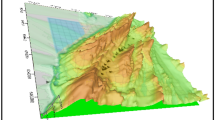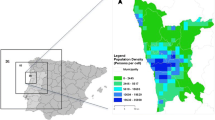Abstract
A modeling framework by linking air quality simulation with system optimization was presented in this paper to develop cost-effective urban air quality management strategies in Fengnan district of China. The relation between the total allowable emission and wind speed as well as the relation between the total allowable emission and air-quality-guideline satisfaction were quantified based on the simulation results of the Gaussian-box modeling system. The area-source emission reduction objective in each functional zone of the study city during the heating and non-heating seasons was calculated based on such relations. A linear programming model was then developed to optimize the emission abatement which was subject to a number of dust and SO2 control measures. The economic objective of the air quality management strategy was to minimize the total emission control system cost while the environmental objective can still be satisfied. The environmental objective was reflected by the emission reduction objective of TSP, PM10 and SO2 corresponding to an air-quality-guideline satisfaction percentage of 80%. Consequently, the modeling system comprehensively took into account the information of emission reduction objectives, emission abatement alternatives, emission reduction cost, and related resources constraints. An optimal emission abatement strategy and the related cost were obtained for various pollution control measures. The results would provide sound bases for decision makers in terms of effective urban air quality management and ensuring healthy economic development in the study city.
Similar content being viewed by others
References
An, X. Q., Chen, Y. C., & Lu, S. H. (2003). Estimation of winter TSP permissible total discharge amount in Lanzhou City. China Environment Science, 23, 60–63.
Borrego, C., Miranda, A.I., Coutinho, M., Ferreira, J., & Carvalho, A. C. (2002). Air quality management in Portugal: example of needs and available tools. Environment Pollution, 120, 115–123.
BUT (Beijing University of Technology). (2004). Research on Atmospheric Environmental Capacity and Air Quality Planning for Fengnan District (in Chinese). China: Beijing University of Technology.
CEPA (China Environmental Protection Administration). (1996). National Ambient Air Quality Standard (GB 3095-1996) (in Chinese). China: CEPA.
Crabbe, H., Beaumont, R., & Norton, D. (2000). Assessment of air quality, emissions and management in a local urban environment. Environental Monitoring and Assessesment, 65, 435–442.
Craig, K. J., De Kock, D. J., & Snyman, J. A. (2001). Minimizing the effect of automotive pollution in urban geometry using mathematical optimization. Atmospheric Environment, 35, 579–587.
Dutta, A., Dikshit, A. K., Ray, S., & Bandyopadhyay, M. (2003). Impact of SO2 emission limits on petroleum refinery operations. I: a linear programming model. Journal of the Environment Systems, 29, 15–38.
Fedra, K., & Haurie, A. (1999). Decision support system for air quality management combining GIS and optimization techniques. International Journal of Environment Pollution, 12, 125–146.
Fisher, B. (2005). Environmental burden of acid gas emissions associated with the exceedence of critical loads. Atmosphric Environment, 39, 1903–1915.
Guariso, G., Pirovano, G., & Volta, M. (2004). Multi-objective analysis of ground-level ozone concentration control. Journal of Environment Management, 71, 25–33.
Hao, J., Wu, Y., Fu, L., He, D., & He, K. (2001). Source contributions to ambient concentrations of CO and NO x in the urban area of Beijing. Journal of the Environment Science Heal. A., 36, 215–228.
HPEPB (Hebei Provincial Environmental Protection Bureau). (2001). Policy on Effectively Controlling Urban Dust Pollution (in Chinese). China: HPEPB.
Ikeda, Y., Yasuda, R., Nakaminami, H., Tanaka, M., Lee, C., & Higashino, H. (2001). A mixed-integer optimization technique for developing a sulfur emission control strategy for China. Water Air Soil Pollution, 30, 65–270.
Krishna, R., Reddy, M. K., Reddy, R. C., & Singh, R. N. (2004). Assimilative capacity and dispersion of pollutants due to industrial sources in Visakhapatnam bowl area. Atmospheric Environment, 38, 6775–6787.
Liu, L., Huang, G. H., Liu, Y., Fuller, G., & Zeng, G. M. (2003). A fuzzy-stochastic robust programming model for regional air quality management under uncertainty. Engineering Optimizing, 35, 177–199.
Lou, J. C., Chung, K. F., & Chen, K. S. (1995). An optimization study of total emission controls for particulate pollutants. Journal of the Environment Management, 43, 17–28.
Loughlin, D. H., Ranjithan, S. R., Baugh, J. W., & Brill, E. D. (2000). Application of genetic algorithms for the design of ozone control strategies. Journal of Air Waste Management, 50, 1050–1063.
Ma, X.M., Cao, Y., & Zhang, F. (2001). Stochastic optimum model for total air pollutant emission control (in Chinese). China Environmental Science, 21, 436–439.
Ma, X. M., & Zhang, F. (2002). A genetic algorithm based stochastic programming model for air quality management. Journal of the Environmental Science (China), 14, 367–374.
Manju, N., Balakrishnan, R., & Mani, N. (2002). Assimilative capacity and pollutant dispersion studies for the industrial zone of Manali. Atmosphric Environment, 36, 3461–3471.
Mediavilla-Sahagun, A., & ApSimon, H. M. (2003). Urban scale integrated assessment of options to reduce PM10 in London towards attainment of air quality objectives. Atmospheric Environment, 37, 4651–4665.
Padmanabha, M. B., & Tangirala, R. S. (1990). An assessment of the assimilative capacity of the atmosphere at Delhi. Atmospheric Environment, 24A, 845–848.
Parra-Guevara, D., & Skiba, Y. N. (2003). Elements of the mathematical modeling in the control of pollutants emissions. Ecological Modelling, 167, 263–275.
Peace, H., Owen, B., & Raper, D. W. (2004). Identifying the contribution of different urban highway air pollution sources. Science of the Total Environment, 334–335, 347–357.
Qin, Y., & Oduyemi, K. (2003). Atmospheric aerosol source identification and estimates of source contributions to air pollution in Dundee, UK. Atmosphric Environment, 37, 1799–1809.
Shih, J. S., Russell, A. G., & McRae, J. (1998). An optimization model for photochemical air pollution control. European Journal of the Operational Research, 106, 1–14.
Tourlou, P. M., Sahm, P., & Moussiopoulos, N. (2002). Integrated assessment of air pollution abatement strategies in urban areas: application to the Greater Athens area. Water Air Soil Polluttion Focus, 2, 731–744.
Wang, L., & Milford, J. B. (2001). Reliability of optimal control strategies for photochemical air pollution. Environmental Science and Technology, 35, 1173–1180.
Yu, T. Y., Lin, Y. C., & Chang L. F. W. (2000). Optimized combinations of abatement strategies for urban mobile sources. Chemosphere, 41, 399–407.
Author information
Authors and Affiliations
Corresponding author
Rights and permissions
About this article
Cite this article
Cheng, S., Li, J., Feng, B. et al. A gaussian-box modeling approach for urban air quality management in a Northern Chinese City—II. pollutant emission abatement. Water Air Soil Pollut 178, 15–36 (2007). https://doi.org/10.1007/s11270-006-9119-9
Received:
Accepted:
Published:
Issue Date:
DOI: https://doi.org/10.1007/s11270-006-9119-9




